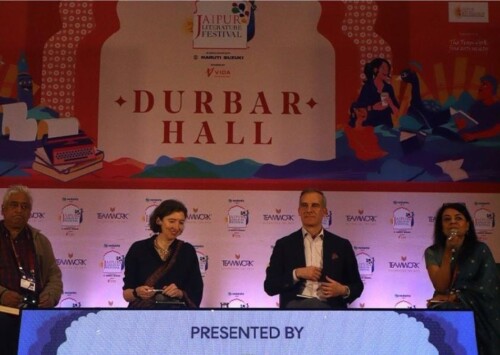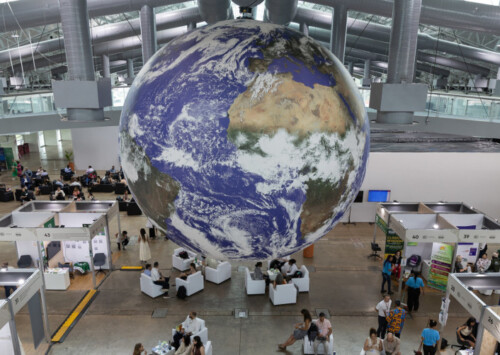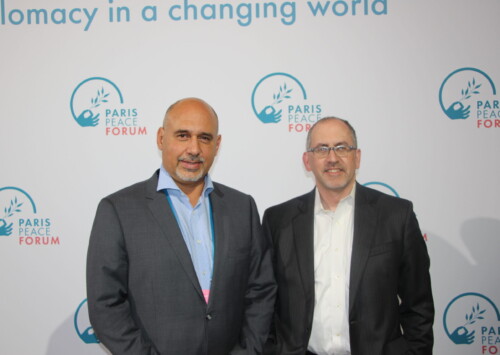Over 200,000 visitors turn up for Jaipur’s Teej Festival and Fair 2025
Cultural celebration highlights women’s leadership, heritage, empowerment
Teej Festival and Fair 2025, organised in Jaipur, Rajasthan celebrated women’s leadership and cultural heritage, with over 200,000 attendees enjoying traditional processions, women-led stalls and vibrant cultural performances.
Under the leadership of Diya Kumari, Deputy Chief Minister and Minister of Tourism of Rajasthan, Teej Festival and accompanying fair held in Jaipur became a vibrant and inclusive expression of feminine power, cultural revival and living tradition. The fair attracted over 200,000 attendees over the course of two days.
The celebration that was organised on July 27-28 and was more than a festival, it was a statement of progress. The theme of feminine leadership was evident at every step and for the first time in the festival’s 298-year royal history, women priests performed the prayer or maha aarti of Goddess Teej Mata.

Diya Kumari
“This year, we have planned the Teej Festival at a much larger scale. Since the festival is wholly dedicated to women, we have consciously designed this edition with women at its core, whether as performers, curators, or cultural ambassadors,” says Kumari.
“We are focussing on attracting tourists even during the shoulder seasons. Festivals like Teej offer us the perfect platform to provide memorable, immersive experiences rooted in our traditions,” she adds.
Female entrepreneurs inaugurated the Teej fair along with Kumari and cultural tableaux designed and curated by women adorned the processional route, reflecting not just participation but ownership.

The grand procession of Teej Mata, commenced at City Palace
The grand procession of Teej Mata, commenced at the Zenana Deorhi of City Palace and proceeded through Tripolia Gate, Chhoti Chaupad, Chogan Stadium, concluding triumphantly at Pondrik Udyan, covering a distance of 1 km in about 1 hour.
The procession was a living tableau of Rajasthan’s heritage, replete with ornately decorated elephants, camels, horses, royal buggies or chariots and a cascade of folk artists.
Most of the performers were women, vividly representing the state’s cultural tapestry. Kumari participated personally in the aarti at Chhoti Chaupad, side by side with Rajasthan Governor Haribhau Bagde, Speaker of Rajasthan Assembly Vasudev Devnani and Uttarakhand’s Tourism Minister Satpal Maharaj, in an event that drew locals, domestic tourists and international visitors.
Among the most dazzling sights were the vibrant processions of women in lahariya saris, singing devotional songs and balancing pots on their heads.

Most of the performers were women, vividly representing the state’s cultural tapestry
Folk dances like Kalbeliya, Ghoomar, Chari and Bhawai, along with traditional puppet shows and Hela Khyal, provided rich musical and visual delight.
The celebrations attracted not just the locals or visitors from other parts of the country, but even abroad.
“I have just witnessed the Teej festival parade. It was a lovely parade with lots of different things, music, entertainment, and beautiful animals. I really enjoyed it, and it is a wonderful day,” Gijs, a tourist from Belgium, tells India & You.
A special focus this year was the Teej Fair at Pondrik Udyan, which turned the procession’s finale into a bustling celebration of women’s enterprise and Rajasthan’s handicraft traditions.
“We had about 25 stalls. The participation and enthusiasm of women was so overwhelming that we had to increase the size of the stalls, some by sharing. While most stalls were from Jaipur, we tried to bring in different crafts and products of interest to women, such as rakhis, sarees, gift items, paintings and blue pottery,” Puneeta Singh, Joint Director, Fair and Festivals, Rajasthan Tourism, tells India & You.
The fair was not limited to local artisans but showcased a wide range of handcrafts and eco-friendly products aimed at boosting women’s participation in local economies.
Each evening, crowds gathered for hour-long cultural performances, featuring bhajans, Ghoomar, Kalbeliya and Bhawai dances, as well as soulful renditions from Rajasthan’s celebrated female folk singers. Alongside artistic expression, the fair offered swings for children, mehndi or henna corners and pop-up stalls serving traditional Rajasthani cuisine, evoking the warm, inclusive atmosphere of a village chaupal or square and inviting everyone, locals and tourists, to experience Rajasthan’s living culture firsthand.

The fair was not limited to local artisans but showcased a wide range of handcrafts and eco-friendly products
The importance of this dual event, the festival and the fair, was amplified by careful organisation, wide publicity, and seamless crowd management.
“It was a sea of humans. And yet there was no mismanagement and everything was smooth as the participants were in that festive mood and this darshan is not done year-round. It comes only at this time, with families ready,” Singh adds.
“This edition of Teej is part of our vision for transformative cultural tourism. The festival remains a cornerstone of Jaipur’s heritage calendar, and this year, the leadership shown by women in every sphere is a beacon for Rajasthan’s progressive social fabric,” Dilip Rathore, Joint Director of Marketing and PR for Rajasthan Tourism Board, tells India & You.
Rituals led by women priests, entrepreneurship by women and cultural creations by women, all harmoniously blended with centuries-old practices, gave the festival a dual role as both a cultural archive and a manifesto for inclusive progress.










